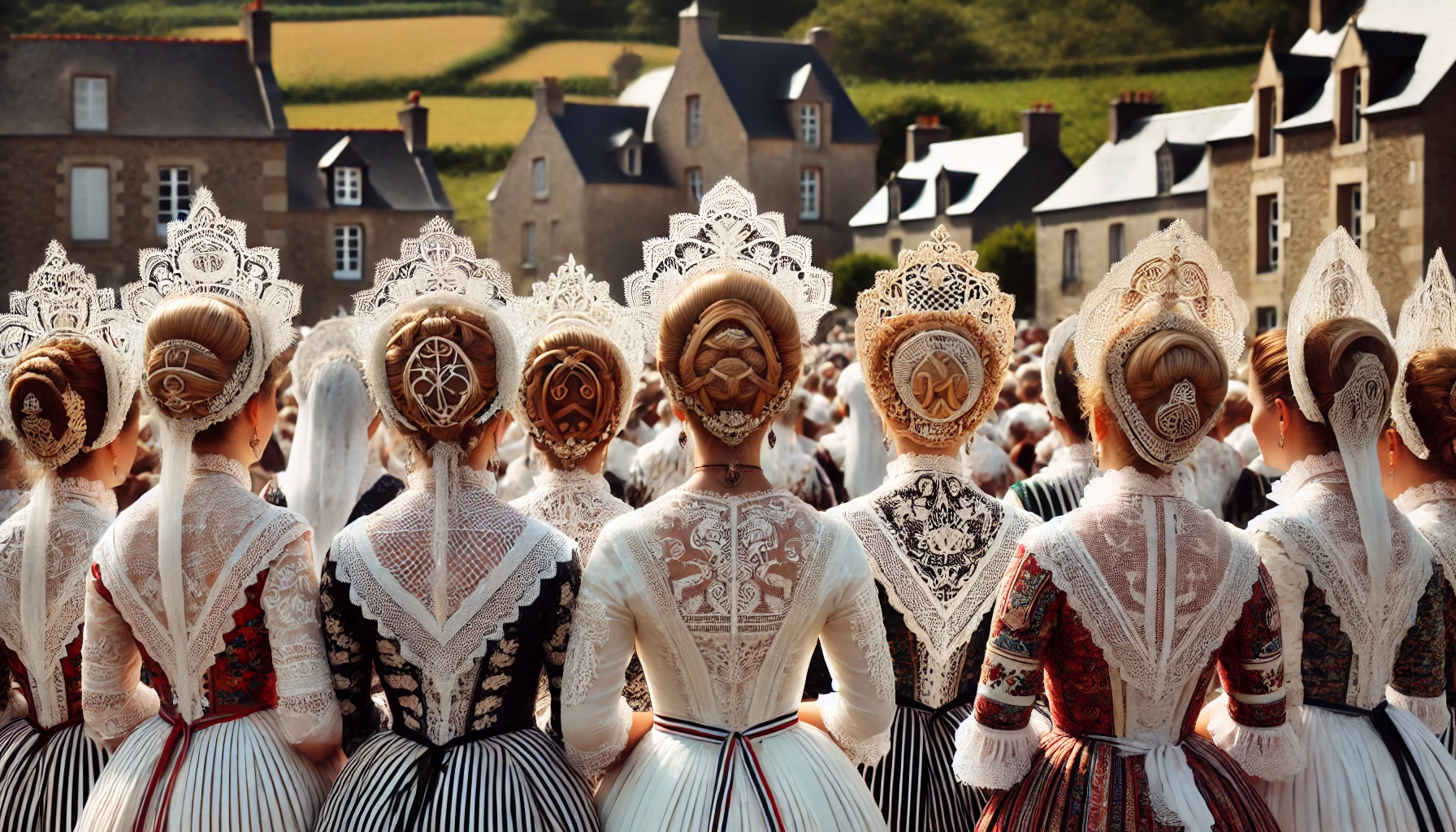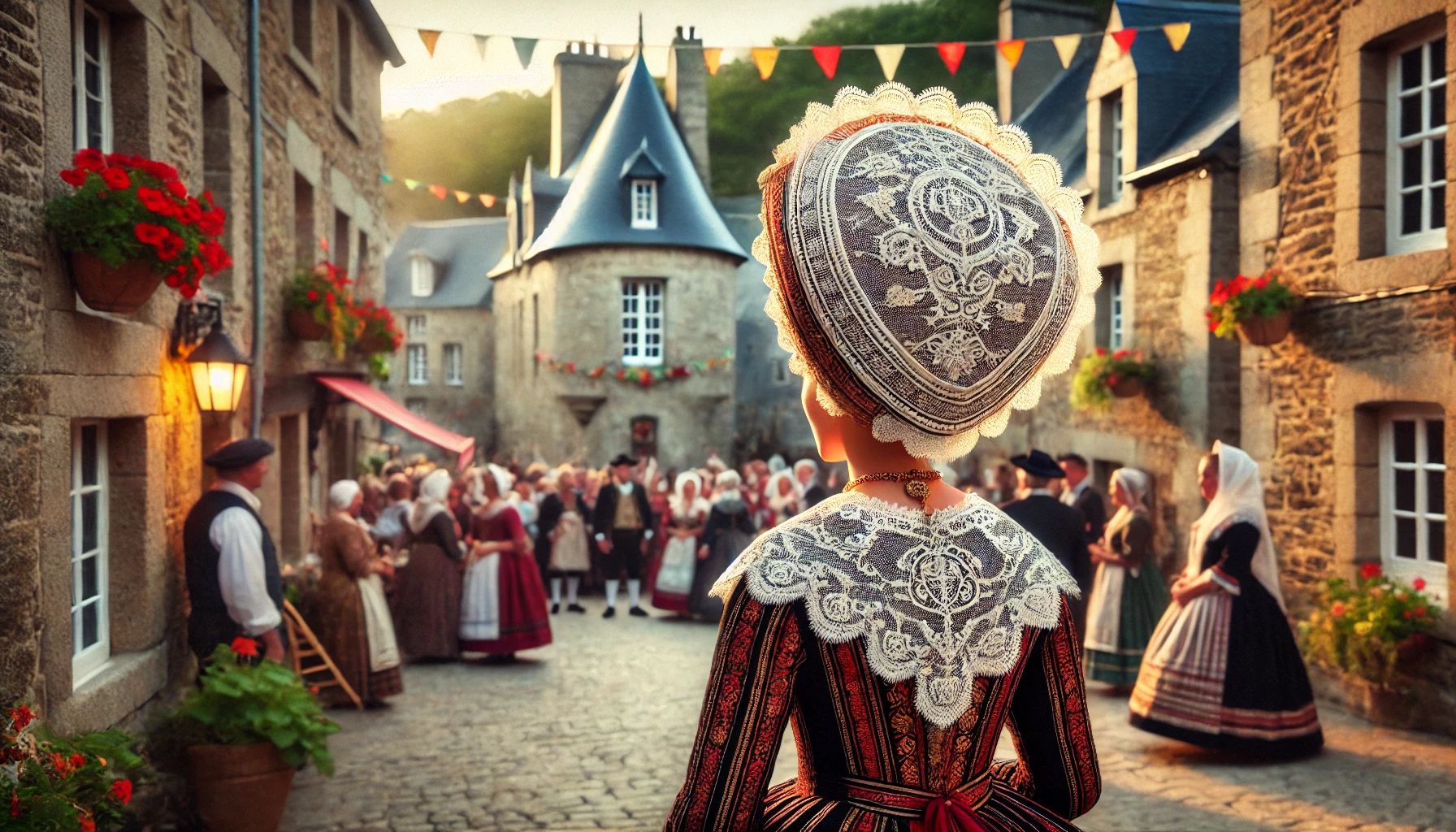
The coiffe from Brittany, France, is a striking and intricate piece of headwear that has captivated the imagination of fashion historians, ethnographers, and culture enthusiasts alike. It serves not only as a symbol of regional identity but also as a reminder of the rich cultural traditions that continue to influence the contemporary world. This iconic headpiece is more than just an accessory; it is a reflection of Brittany’s complex social and cultural history, shaped by its geographical location, customs, and community values.
From its delicate lace and complex patterns to its ceremonial importance in weddings and festivals, the coiffe has played a central role in the lives of Breton women for centuries. In this article, we will explore the history, styles, cultural significance, and contemporary influence of the coiffe from Brittany, shedding light on why it remains a cherished part of French heritage.
The History of the Breton Coiffe: Tracing its Origins
The coiffe has a long history that dates back several centuries, with its origins tied closely to the rural communities of Brittany. Its design evolved over time, but it has always remained a distinct marker of regional identity. Brittany, a peninsula in northwestern France, has long been known for its unique customs, language, and sense of autonomy, and the coiffe is one of the most visible representations of this distinctiveness.
Originally, the coiffe was worn as everyday attire by women across all social classes, serving both a practical and symbolic function. It protected the wearer from the elements while also indicating her marital status, social rank, and even her hometown. Different regions within Brittany had their own variations of the coiffe, and certain designs could only be worn by women from specific villages.
In the 19th century, as France underwent significant political and social changes, including industrialization and urbanization, the coiffe began to transition from a daily necessity to a ceremonial item. As more Breton women moved to urban centers, the headpiece became a proud symbol of cultural identity, worn during special events and festivals rather than in daily life. Despite its evolution, the coiffe never lost its significance, and today it remains an enduring symbol of Brittany’s rich cultural tapestry.

The Evolution of the Coiffe: From Daily Wear to Special Occasions
In the past, the Coiffe of Brittany was an everyday accessory for Breton women, each region having its own variation of the style. These headdresses, typically made of lace, varied in size and shape, with some standing tall and others laying more flat. Traditionally, the coiffe was a symbol of status and local identity, often passed down through generations.
Today, the coiffe is no longer a daily accessory but is instead reserved for special occasions such as regional festivals, weddings, and cultural events. This transition has allowed the coiffe to become more symbolic, highlighting Brittany’s rich heritage. During these occasions, women don their coiffes with pride, showcasing not just the headdress but also the breton traditions that it represents.
While the coiffe has largely shifted away from daily wear, its use in these cultural events keeps the tradition alive. It serves as a living reminder of Brittany’s historical identity, bringing together both the older and younger generations in celebrating their roots.
Variations of the Coiffe: A Diversity of Styles
One of the most fascinating aspects of the Breton coiffe is the sheer variety of styles that exist across different regions of Brittany. While all coiffes share certain basic elements—such as being made of lace or linen and worn on the head—the specific designs can differ dramatically, sometimes within just a few miles of each other.
For example, the “Bigoudène” coiffe, perhaps the most well-known, features an impressively tall, cylindrical structure that can reach up to 30 centimeters in height. This style comes from the Bigouden region in southern Brittany and is often elaborately decorated with lace and embroidery. The Bigoudène coiffe has become one of the most iconic symbols of Brittany, frequently featured in cultural festivals and tourist souvenirs.
In contrast, the coiffe from the town of Pont-Aven is much simpler, with a wide brim and a more compact structure. Known for its association with the art colony that included painters like Paul Gauguin, this coiffe is understated but elegant, reflecting the artistic and pastoral traditions of the region.
There are also coiffes that are uniquely tied to specific occasions. For instance, some styles were traditionally reserved for weddings, while others were worn during religious ceremonies or town festivals. The materials used also varied depending on the event; wedding coiffes, for example, were often made from the finest lace and took weeks or even months to complete.
The Cultural Significance of the Coiffe: More Than Just Headwear
The Breton coiffe is far more than a fashion accessory. It holds deep cultural and symbolic meaning, particularly in the context of Breton society. Historically, the coiffe was a marker of a woman’s life stages. Young girls would begin wearing simple versions of the coiffe at a very early age, with the design becoming more elaborate as they grew older. A young woman’s marital status could often be determined by the style and intricacy of her coiffe; single women typically wore coiffes with simpler designs, while married women were allowed to wear more ornate versions.

Wearing a coiffe was also a way of signaling one’s adherence to tradition and connection to the Breton community. In times of social change, when many rural populations were moving to cities or adopting more modern styles of dress, the coiffe became a powerful symbol of resistance to assimilation. It represented the wearer’s commitment to preserving the values and customs of their ancestors.
The coiffe also played a prominent role in religious and communal ceremonies. It was not uncommon for a family to pass down a coiffe from one generation to the next, adding layers of meaning to the already deeply symbolic garment. The coiffe thus served as a tangible link to the past, connecting the wearer to the cultural history of her community and family.
The Coiffe in Contemporary Times: A Living Tradition
While the coiffe is no longer worn daily, its cultural significance has not diminished. Today, it plays a prominent role in Brittany’s many festivals and cultural celebrations, most notably during the famous “Fête des Brodeuses” (Festival of Embroiderers) in Pont-l’Abbé, where women don the traditional attire to celebrate their heritage. The coiffe is also frequently worn at weddings, religious ceremonies, and other formal occasions, acting as a proud emblem of Breton identity.
Contemporary designers and artists have also begun to incorporate the coiffe into modern fashion, using its lace patterns and structural designs as inspiration for new creations. Some designers have reimagined the coiffe as a chic, minimalist accessory for the 21st century, while others have stayed true to its traditional roots, creating elaborate reproductions of historical styles. This blending of old and new reflects the ongoing relevance of the coiffe in contemporary French culture.
Moreover, the coiffe continues to be a subject of fascination for cultural scholars, who study its evolution as a marker of gender, class, and regional identity. Museums in Brittany and across France often showcase coiffes in their exhibits on folk traditions, highlighting the garment’s importance as both a historical artifact and a living tradition.
How Modern Designers Are Reviving the Coiffe
In recent years, the fashion industry has taken an interest in traditional styles, including the Coiffe of Brittany. Modern designers are infusing contemporary flair into the classic design, making it more appealing to younger audiences who want to reconnect with their heritage in a fashionable way. This creative approach helps ensure that the coiffe tradition does not fade away but instead evolves with time.
Some designers have begun creating simplified versions of the coiffe, making them easier to wear with everyday outfits. These adaptations include using lighter materials or reducing the size of the traditional lace structures, allowing the coiffe to become more versatile. For example, the large, elaborate coiffes often seen during festivals are reimagined in smaller, minimalist forms, making them suitable for casual wear.
This revival has breathed new life into the coiffe, helping it find a place in the wardrobes of those who appreciate a balance between old-world charm and modern aesthetics. The collaboration between designers and local artisans also plays a crucial role in keeping the traditional techniques of lace-making and coiffe design alive.
Wearing the Coiffe Today: A Guide for Modern Enthusiasts
For those who wish to embrace the Coiffe of Brittany today, there are several ways to integrate this traditional piece into a modern look. While the traditional versions may seem daunting due to their size and intricate lacework, modern adaptations make it easier for anyone to try out this cultural accessory.
Firstly, pairing a small coiffe with contemporary clothing can create a unique look that celebrates tradition while remaining fashionable. Think of a classic Breton striped shirt with a simplified lace coiffe—this combination reflects a love for Brittany without being overly formal. It’s a great way to blend local pride with everyday style.
Secondly, for formal events or celebrations such as Breton weddings, wearing a traditional coiffe can add a touch of elegance and authenticity. Many women choose to wear their coiffes with period-specific Breton dresses, often using these moments to connect with their heritage on a deeper level. This pairing is perfect for those looking to recreate a sense of the past with authenticity.
Lastly, some enthusiasts have begun incorporating coiffes into modern bohemian or vintage-inspired looks. By combining the coiffe with modern accessories, such as denim or light summer dresses, the coiffe can take on a fresh and trendy vibe. This mix of old and new highlights the versatility of the coiffe and how it can be adapted to different styles and settings.
The Role of Festivals in Keeping the Coiffe Tradition Alive
Festivals play a crucial role in maintaining the cultural significance of the Coiffe of Brittany. Each year, various celebrations across the region, such as the Festival Interceltique de Lorient or local Breton dance festivals, feature women proudly wearing their coiffes. These events provide a stage for displaying the artistry behind each piece, bringing together locals and visitors alike in appreciation of the region’s heritage.
At these festivals, young women are taught how to wear and care for their coiffes, ensuring that the skills needed to maintain this tradition are passed down through generations. This education is vital for preserving the knowledge of how to arrange and secure the delicate lacework that characterizes each coiffe, maintaining the unique breton identity.
Moreover, the festivals serve as an opportunity for modern adaptations of the coiffe to be showcased, as designers and wearers experiment with new styles. This exchange between traditional and contemporary interpretations of the coiffe keeps the tradition dynamic, fostering a culture of innovation that respects the past while embracing the future.
The Coiffe of Brittany has evolved significantly over the years, transforming from a symbol of daily life into a cherished cultural icon. Whether worn during festivals, adapted by fashion designers, or incorporated into modern wardrobes, the coiffe continues to be a beautiful representation of Breton heritage. By blending tradition with modernity, it remains a living part of Brittany’s culture, reminding us of the region’s rich history and its enduring charm.
Conclusion: The Timeless Allure of the Breton Coiffe
The coiffe from Brittany stands as a testament to the enduring power of tradition and cultural identity. Despite the sweeping changes brought by modernity, the coiffe has remained a symbol of pride and continuity for the Breton people. Its intricate designs, regional variations, and rich history make it one of the most fascinating elements of French cultural heritage. Whether viewed as a historical artifact or a living symbol, the coiffe embodies the spirit of Brittany and the timeless connection between fashion and identity.
This exquisite headpiece not only tells the story of a region but also serves as an inspiration for future generations, ensuring that the traditions of the past continue to resonate in the present and future. Whether seen at a festival in Brittany or on a runway in Paris, the coiffe continues to captivate audiences, proving that its allure is as powerful today as it was centuries ago.








